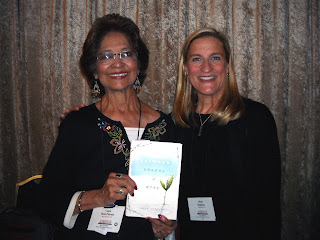I’d like to share with you a piece that I wrote, which was published in the Nov/Dec 2012 issue of the national SCBWI bulletin. I hope you like it.
Adventures in Book Signings
By Lupe Ruiz-Flores
Have you ever had to compete with Santa Claus at a book signing? It’s tough competition when you’re trying to hawk your book with Santa only a few feet away, bellowing his Ho-Ho-Ho’s, and giving away candy. Or how about when a customer at a supermarket comes up to the author table and asks, “Where are the flu shots being given? Does Medicare cover this?” Or a lady at a store waves a circular in your face wanting to know, “Where are the specials for pork chops?”
I experienced all of the above when my first picture book was published. My most memorable signing, however, happened at an Herb Festival. As a new author, I was eager to do a reading anywhere and accepted the invitation with an immediate “yes.” Herb festival? What was I thinking? When I arrived, I headed for the tent with the big sign, “Author Reading/Signing.” Impressive, I thought.
Folding chairs were already set up under the tent … except they were empty. I looked at my watch. Yep. I was on time. But where were the people? The person who had invited me tried to reassure me. “I’m sure you’ll get a crowd in a little while.” Then she left to attend to other duties.
I waited and waited and waited. Finally, a lady in a tie-dyed blouse showed up. She carried a white paper kite under her arm and a box of brushes and paints under the other. “Are you the author?”
I nodded. Oh, goodie. My first attendee.
“I’m the artist,” she said, to my surprise. “I’m here to paint this kite in the background while you do your reading.
Wow. I have my own artist. She looked at the empty chairs. “Where’s the kids?”
I shrugged. “There’s not any around here, I don’t think.”
“There must be. Let’s go find them.”
“Are you serious?” I asked.
“C’mon.”
I followed as we scoured the grounds looking for kids. The majority of the crowd was couples buying plants, herbs, and potting soil. We found a clown but no kids. Suddenly we spotted two little girls around four years old. We went up to the parents and invited them to our tent for the reading.
The parents graciously accepted. I started my reading. The artist did her thing with the kite. After a few minutes, one of the little girls spotted the clown. He was blowing up balloons and she wanted one. Her mother gave me a weak smile, indicated she had to leave, and towed her little one away to see the clown. I was left with an audience of two—one child and the mother. I focused on the little girl because she really seemed interested in my story. I gave it my all. She clapped at the end. That was my smallest audience ever, but to me, the most appreciative. I gathered up my books, my multi-colored kite, bought an herb plant on the way out, and smiled all the way home. What did I learn? Respect and entertain your audience, even if it’s only one.
“A good book is the best of friends, the same today and forever.” — Martin Farquhar Tupper










